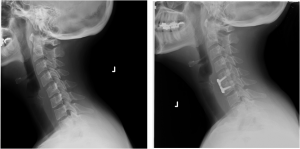Anterior cervical discectomy and fusion, often abbreviated ACDF, is a commonly performed procedure for treatment of cervical spine (neck) disorders. An ACDF is usually performed to treat a degenerated or herniated disc in the neck. Disc degeneration and herniation are two common disc-related problems that may compress spinal nerve roots or the spinal cord that resides within the spinal canal.
Compression or pinching of these neurologic structures may result in neck, shoulder, upper back, and arm pain. Other neurologic symptoms may include numbness, tingling and weakness in the arms or hands. The goal of an ACDF is to decompress the nerve root(s) and spinal cord, stabilize the neck, relieve symptoms, and enable the patient to return to regular activities of daily living.
Anterior = front
The surgical incision is made in the front of the neck either on the left or right side. The incision can often be performed within a natural skin crease or skin fold helping to conceal the surgical incision when healed and provide a pleasing cosmetic result.
viewmed
Cervical = neck
The cervical levels are one region of the spine. There are seven vertebral bodies in the neck; numbered C1 (top) through C7 (bottom). The disc levels are also abbreviated. For example, C3-C4 refers to the intervertebral disc between the third and fourth cervical vertebral bodies (bones).
Discectomy = to remove the disc
Through the incision, the surgeon moves soft tissues aside to reveal the disc. Using special instruments, the surgeon removes the ruptured disc from between the upper and lower vertebral bodies.
Fusion = to join or combine
Bone graft is inserted into the empty space between the upper and lower vertebral bodies. Instrumentation (cervical plate and screws) is implanted to immobilize (stabilize) the neck. The body’s natural healing processes cause new bone to grow into and around the instrumentation resulting in a spinal fusion.
Not every patient with a cervical degenerative disc problem or disc herniation requires spine surgery. Dr. Stieber may recommend an anterior cervical discectomy and fusion for the following reasons: if non-operative treatment fails to relieve symptoms, progressive worsening of neurologic symptoms or pain, spinal instability, and/or neurological problems. Numbness, loss of function, and weakness are examples of neurologic dysfunction.
About Cervical Discectomy
ACDF is performed under general anesthesia. The neck is cleansed and prepared for surgery. An incision is made on the left or right side of the neck. Muscles and other tissues are gently pulled aside to expose the disc. Dr. Stieber uses fluoroscopy, a type of real time x-ray during surgery. A thin needle is inserted into the disc, which can be viewed on fluoroscopy. Specialized surgical instruments are used to remove the ruptured disc. A spreader instrument gently separates the vertebral bodies while the disc and smaller disc pieces are removed. Disc material and bone spurs (osteophytes) that compress (pinch) spinal nerve roots are carefully removed. Bone graft fills the empty space after discectomy.
Types of Bone Graft
● Autograft is the patient’s own bone; usually taken from the hip.
● Allograft is donor bone from a bone bank.
● Bone graft substitute; there are different types, some of which are synthetic (man-made) and available in different shapes.
Screws affix a metal plate over the bone graft. The plate holds the graft in place and stabilizes the neck. Although fluoroscopy is used during ACDF, a post-operative x-ray is taken to ensure the bone graft and instrumentation is well-positioned.
After Surgery
After surgery, the patient is moved into the recovery area. In recovery, nurses and other members of the medical team closely monitor the patient’s vital signs – pulse, respiration, blood pressure, and pain. Some post-operative pain should be expected and patients receive pain medication either through their IV (intravenous line) or by mouth.
● A post-operative cervical brace may be prescribed to wear for a period after surgery to help immobilize and support the neck while healing.
● Many patients go home the same day as surgery. Dr. Stieber discusses the likelihood of hospitalization with patients before their surgery date.

Pre and post operative x-rays of a 49 year old female who was treated with an ACDF
After Care at Home
Dr. Stieber provides ACDF patients with information about what to expect and self-care after hospital discharge. This information includes instructions to control pain, medications, diet and managing constipation, bathing and incision care, activity restrictions, and the surgical follow-up appointments. As always, Dr. Stieber and his staff welcome questions and ensure that all patient concerns are thoroughly addressed.
